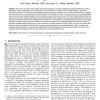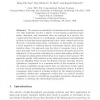36 search results - page 4 / 8 » From Gene Trees to Species Trees through a Supertree Approac... |
111
Voted
TKDE
2008
14 years 11 months ago
2008
We study a new data mining problem concerning the discovery of frequent agreement subtrees (FASTs) from a set of phylogenetic trees. A phylogenetic tree, or phylogeny, is an unorde...
BMCBI
2008
14 years 11 months ago
2008
Background: The availability of sequences from whole genomes to reconstruct the tree of life has the potential to enable the development of phylogenomic hypotheses in ways that ha...
102
Voted
BMCBI
2007
14 years 11 months ago
2007
Background: Construction and interpretation of phylogenetic trees has been a major research topic for understanding the evolution of genes. Increases in sequence data and complexi...
139
Voted
ISBRA
2010
Springer
14 years 10 months ago
2010
Springer
The random accumulation of variations in the human genome over time implicitly encodes a history of how human populations have arisen, dispersed, and intermixed since we emerged as...
88
Voted
BMCBI
2010
14 years 11 months ago
2010
Background: Phylogenies capture the evolutionary ancestry linking extant species. Correlations and similarities among a set of species are mediated by and need to be understood in...


